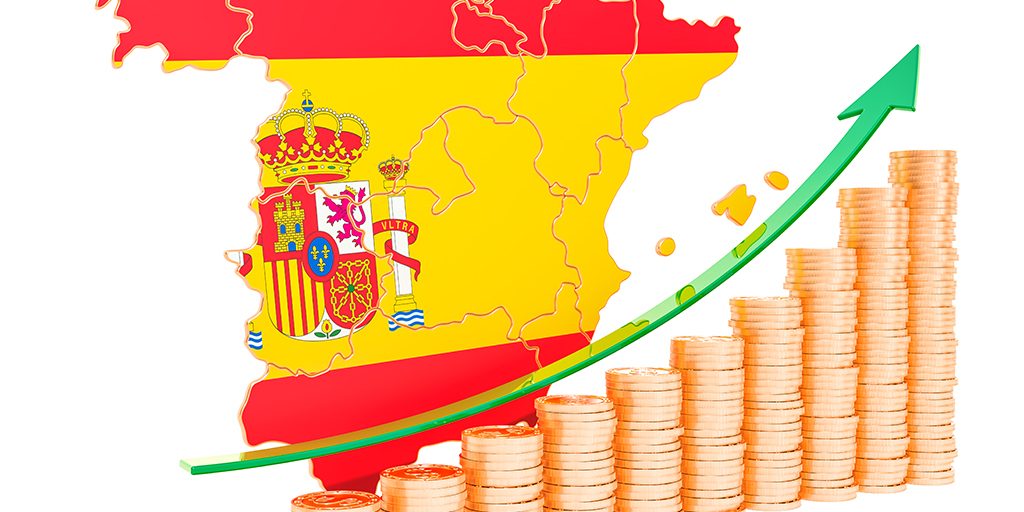Spain, the Best Economy of the Eurozone.
Spain economy is the best, experiencing remarkable growth compared with its neighbors in Eurozone. In 2024, the projected growth rate is anticipated to be nearly four times that of its European counterparts.

Spain’s economy is soaring
In 2024,The Spanish GDP is growing by 3.5%, surpassed only by Israel (6.7%) and Greece (3.7%). The country has been in the headlines recently by being named the best economy of 2024 in the annual rankings from The Economist.
Spain’s faster growth rate compared to its Eurozone peers highlights its adaptability, strategic vision, and ability to leverage its unique strengths. By investing in sustainability and innovation, Spain is positioning itself not only as a leader in the Eurozone’s recovery but as a global economic contender.
This impressive rebound from the pandemic has resulted in the creation of 1.8 million new jobs since 2019, highlighting the robustness of the labor market. By the conclusion of 2024, employment figures are expected to exceed 21.3 million, marking the highest level in the nation’s history, as reported by Spain’s ministry of employment and social security.
The financial sector is also taking note; for the first time since 2007, investors are viewing Spanish government bonds as safer than those of France.
What’s driving the success of the Spanish economy?
- Spain ranks as the second-largest beneficiary, following Italy, of the European Union’s Next Generation recovery funds, which are part of the post-pandemic aid initiative.
- The tourism sector is also experiencing a revival, with an increasing number of individuals selecting Spain not only as a travel destination but also as a place to reside and work.
- The country is experiencing significant workforce growth due to robust immigration trends, as many individuals are relocating to Spain, contributing new skills and vitality.
- Additionally, service exports are on the rise, particularly in the technology and consulting sectors, which are expanding swiftly. Furthermore, there has been a notable increase in public investment.
– Tourism the king.
One of the pillars of Spain’s economic strength is its tourism industry, contributing nearly 12% of its GDP. As one of the world’s most visited countries, Spain consistently attracts millions of international tourists annually. Iconic cities like Barcelona, Madrid, and Seville, alongside coastal regions such as Costa del Sol and the Balearic Islands, contribute significantly to the nation’s GDP. The sector’s post-pandemic recovery has been swift, supported by renewed global travel and strategic investments in infrastructure and sustainability.

– Inflation.
Prices are stabilizing. Inflation is projected to decrease from 2.8% in 2024 to 2.0% by 2026, primarily as a result of a decline in food and energy prices. While certain costs, such as those associated with hotels and transportation, are taking more time to decrease, the general trend remains favorable.
– Renewable Energies and Innovation.
Spain’s commitment to renewable energy further cements its leadership in the Eurozone. With ambitious goals to reduce carbon emissions, the country has become a frontrunner in solar and wind energy production. This green transition not only addresses environmental concerns but also positions Spain as an innovative hub for sustainable practices.
Moreover, Spain’s startup ecosystem has flourished, with cities like Madrid and Barcelona becoming hotspots for innovation and entrepreneurship. Investments in digital infrastructure and a skilled workforce have propelled the nation into a competitive position globally.
– What about unemployment?
The unemployment rate is projected to decrease from 11.5% in 2024 to 10.7% by 2026, and wages are increasing at a rate that exceeds inflation, resulting in enhanced purchasing power for individuals.

Spain Economy Forecast 2025.
The outlook for the future appears optimistic. Although growth may experience a minor deceleration, projected at 2.3% in 2025 and 2.1% in 2026, it is anticipated to remain one of the most robust in Europe. Consumer spending is on the rise, businesses are increasing their investments, and job creation is on the upswing. An article published by CaixaBank Research at the end of the previous year indicated: “For 2025, we expect the economy to moderate its growth rate slightly to 2.3%. This is nevertheless a high rate and well above the 1.3% expected for the euro area.” Furthermore, “we also expect an average net creation of over 400,000 jobs in 2025, and a slight fall in the unemployment rate, elements that will allow more wealth to be created and will bolster household consumption.”
Conclusion: Spain Economy, the envy of the Eurozone.
Spain has emerged as a notable economic success within Europe. Although challenges remain, the nation has developed a more robust and diverse economy that is generating employment, drawing in investments, and demonstrating remarkable growth. The focus has shifted beyond tourism; Spain is evolving into a contemporary and dynamic economy that serves as a model for other European countries.
It is obvious that Spain economy will keep growing faster than most European neighbours, but what about the house price forecast in Marbella for 2025?


